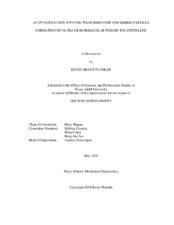| dc.description.abstract | Ultra-high molecular weight polyethylene (UHMWPE) is a popular choice for bearing material due to its low wear and low friction coefficient. It remains the primary material for use in artificial joints, which has led to an extensive history of tribologic study, and has resulted in a variety of techniques for reducing total wear volume. However, very little is known regarding the actual mechanisms that lead to individual debris particle formation. Applying well-established wear testing techniques specifically to explore UHWMPE wear mechanisms may open new insights and new possibilities for engineering long lasting joints
.
First, wear debris image analysis was applied to debris collected after UHMWPE pins were worn against counterfaces of three different roughnesses, and then imaged in a scanning electron microscope. The debris was characterized using standard analysis techniques: equivalent circle diameter (ECD), roundness factor, and Richardson fractal dimension. Results revealed evidence of abrasion, adhesion and fatigue processes, but a large percentage of particles were small and smooth, and were not easily classified. It is hypothesized that these particles are the result of plastic deformation at the wear interface.
Analysis of the resultant wear surface of UHMWPE samples is also suggestive of plastic deformation, including an often observed but never explained ripple pattern. Computer modeling supports the notion that deformation takes place at the surface, which led to the conclusion that a thin layer of strained polymer can buckle during relaxation, resulting in a rippled geometry. In this case, the final ripple wavelength would be determined by the thickness of the deformed layer.
To test this hypothesis, computer models were used to predict the effects of contact pressure, temperature, and counterface roughness on the rippled surface geometry. Corresponding experimental tests did reveal high levels of plastic deformation, but in much thinner sections than anticipated. Additionally, the experimental effects of pressure and temperature did not match the simulations and suggested that the ripple formations are more dynamic than previously thought, and are the result of a thin, self-adhering transfer film rather than straining of the bulk polymer itself. | en |


